Is 5G something we should be worried about? There are health concerns
The roll out of 5G wireless service is 'a massive health experiment' | Daily Mail Online
The roll out of 5G wireless service is 'a massive health experiment' | Daily Mail Online
It is generally not a good idea to get science from newspapers, especially popular ones. The article says that the millimetre wave will be mainly concentrated in the skin (probably true) but then says that it could affect testes - last time I checked the testes were safely inside a bag made of skin so the article seems to contradict itself. In any case, as for all mobile phone technologies, you can protect yourself from almost all of the radiation by not using a mobile device (and not climbing base station towers).
Science in the daily mail... see:
Kill or cure?
Oh - and no, 5G - if it ever gets rolled out - won't be a problem. 4G is still slowly rolling out, a few years from completion yet.
Kill or cure?
Oh - and no, 5G - if it ever gets rolled out - won't be a problem. 4G is still slowly rolling out, a few years from completion yet.
It is generally not a good idea to get science from newspapers
This line from the linked article is WRONG, and contradicts what's stated later in the same article.
and no, 5G - if it ever gets rolled out
It's already here in some big US cities. Mostly used for backhaul.
The microwave networks are nearly saturated, hence the switch to the virtually untouched, lower frequency MMWs for 5G.
As with the transition from 3G to 4G the two big players in the US have already taken some of the principles and standards from the 5G spec and applied then to their 4G network in existing frequency bands. AT&T in particular used this to call their 3G network "4G." Several years ago. Their true 4G coverage was then called "LTE." It remains to be seen how the marketing people will handle the 5G transition.
Today's cellular phones operate over several frequency bands from around 600 MHz to 3 GHz. Frequencies above 1 GHz have poor penetration into buildings especially those made of concrete and steel. Also the range of radio waves above 1 GHz is less than those of higher frequencies. Cell towers use the sub 1GHz frequencies to reach people inside buildings and those above 1 GHz for outdoor users like those in cars.
All of this voice and data traffic needs to be taken from the cell tower to the central switching office. This is known as "backhaul." Much of this is fiber, but a lot is still microwave.
As more users fill up a given area, the radio channels get crowded, and eventually reach their maximum capacity. This limits the number of users OR the data rate per user. To counter this, the cellular carriers reduce the power in each cell site and add more cells. There is a limit to how far this can be taken due to the cost of installing cells, interference between cells, and the logistics of connecting them all together. Large office buildings, shopping malls and the like employ "microcells" which are interconnected by wire, fiber, microwaves, or recently millimeter waves.
Millimeter waves are technically those with RF frequencies in the 24 GHz and up range. Some frequencies in the 24 to 30 GHz band have proposed for 5G with future allocations up to 86 GHz. These will be primarily used for fixed point interconnection and backhaul at least at first since a 24GHz transmission at the power level capable in a cell phone sized device will have very limited range, and as stated absorbed by human tissue, hence rather useless in crowded placed.
Worried about being zapped by millimeter waves, stay away from the roads since the collision avoidance radar being used in some cars and trucks uses millimeter waves in the 24 and 33 GHz range.
know what the actual engineering situation is.. Not what their marketing guys say!
Ditto, I was an RF engineer for Motorola for 41 years. We knew what was going on, not what the carriers were selling.
I think what DF96 is saying is that the article is a 'load of cobblers'*last time I checked the testes were safely inside a bag made of skin so the article seems to contradict itself.
*An example of Cockney rhyming slang. Cobblers' awls were pointed hand tools that cobblers use to pierce holes in leather. The word 'awls' rhymes with 'balls', meaning testicles.
5G whitepaper by Skyworks:
http://www.skyworksinc.com/downloads/literature/Skyworks-5G White-Paper_Part2.pdf
5G in 5 minutes --
SKYWORKS : 5G Video - 5G in Five Minutes
Interesting American Tower doesn't think 5G will require more cell towers, just more equipment.
http://www.skyworksinc.com/downloads/literature/Skyworks-5G White-Paper_Part2.pdf
5G in 5 minutes --
SKYWORKS : 5G Video - 5G in Five Minutes
Interesting American Tower doesn't think 5G will require more cell towers, just more equipment.
The current density of cell towers in the area where towers are needed is probably sufficient to get enough data to the users if some of the "5G" techniques are applied to them. Problem areas today are usually places where human population density is very high. This is often the "urban canyons" and "concrete jungles" where there are plenty of buildings to house these people, whether it is high rise workplaces, or large living complexes. These structures themselves ARE the tower. There will be more equipment added, probably on each floor, and more equipment added to the roof to relay all of the aggregate data to the closest point of access to a fat fiber optic pipe, probably an existing tower.
Where I live, there is no cell signal. Both AT&T and Verizon show coverage here, and I can get one bar on my phone sometimes, but you can't sustain a call. Neither plan on installing a tower to service this area since the population density isn't high enough. If I go somewhere where I can get a signal, it is fast enough to stream 4K video without dropouts.
Where I live, there is no cell signal. Both AT&T and Verizon show coverage here, and I can get one bar on my phone sometimes, but you can't sustain a call. Neither plan on installing a tower to service this area since the population density isn't high enough. If I go somewhere where I can get a signal, it is fast enough to stream 4K video without dropouts.
We have areas like that here. The "Horseshoe" up near Watauga and "Little Wilber Dam" is like that. Same up HWY-92 out of Elizabethton and a lot of Cherokee (Erwin, Unicoi etc).
If you are down in the flatlands you are ok. Hit the mountain valleys and it gets iffy real fast.
If you are down in the flatlands you are ok. Hit the mountain valleys and it gets iffy real fast.
There are several places where a single tower, maybe 10 feet tall could serve the whole town and most of the valleys and ridges to the south where we live. The problem with doing that is similar to the REAL reason you aren't allowed to use a cell phone on an airplane.
In the airplane scenario, a cell phone user up in the air would hit a hundred towers or more at the same time. There is a good possibility that these towers could be connected to two or more switching centers. This is not anticipated in the network plan and would cause undue processing, and probably confuse the call routing / voting system. One user doing this isn't going to be a problem, but a hundred at a time could choke the system.
In the tower on a big hill overlooking the Ohio River (barge traffic, large chemical and power plants, and 4 lane roads run along either side), the town of Moundsville, and several roads with lots of transient workers from the fracking industry scenario you have the opposite problem. The system would need a large bandwidth and capacity during the two peak traffic periods during the day, but sit nearly idle for the rest of the time.....a large expensive system without the data flow per month that the same system in the middle of a big city would generate. Cell phone yackers and testing drivers generate zero revenue for the carrier, plans make money on data charges.
The county public safety system has it's tower up there to serve all the police, fire and EMS radio traffic. Nextel had a tower there in the 2G days, and it worked great. My Nextel phone worked in places that AT&T and Verizon didn't including most of the town.
We were working on an early version of "aggregation" as mentioned in the Skyworks report for Nextel to give them 3G speed, but Sprint bought Nextel and killed them for the sub 1 GHz spectrum, and Spirnt never built out here. The Nextel tower was not sold to Crown Castle or American Tower in the great tower sell off and was eventually torn down.
Note that Comcast has started a phone service using a business model that we (Motorola) proposed a dozen years ago. In a sense it's a lot like where 5G is going except that it's using Comcast's coaxial cable and fiber network for backhaul. If they had better reliability here (our cable is always acting up) and didn't require using an expensive phone that's only available from them, I would be tempted. The phone passes voice, text and data to the Comcast box that's already in the house over WiFi whenever it's in range of ANY Comcast box. Here, since there is no over the air TV, that's almost anywhere in town. When you are not in range of a Comcast box the phone roams on Verizon. They do not charge anything for voice or text, just data, and the price is reasonable......for now. It WILL go up if this catches on.
Last week I got a letter from Comcast stating that there was a problem with my box, and they were sending me a new one. I was to swap the box and hand the old one off to UPS for return. The only difference I noted, a much stronger WiFi signal, especially on 5 GHz. It now reaches over 500 feet around the house and I have it in the basement.
In the airplane scenario, a cell phone user up in the air would hit a hundred towers or more at the same time. There is a good possibility that these towers could be connected to two or more switching centers. This is not anticipated in the network plan and would cause undue processing, and probably confuse the call routing / voting system. One user doing this isn't going to be a problem, but a hundred at a time could choke the system.
In the tower on a big hill overlooking the Ohio River (barge traffic, large chemical and power plants, and 4 lane roads run along either side), the town of Moundsville, and several roads with lots of transient workers from the fracking industry scenario you have the opposite problem. The system would need a large bandwidth and capacity during the two peak traffic periods during the day, but sit nearly idle for the rest of the time.....a large expensive system without the data flow per month that the same system in the middle of a big city would generate. Cell phone yackers and testing drivers generate zero revenue for the carrier, plans make money on data charges.
The county public safety system has it's tower up there to serve all the police, fire and EMS radio traffic. Nextel had a tower there in the 2G days, and it worked great. My Nextel phone worked in places that AT&T and Verizon didn't including most of the town.
We were working on an early version of "aggregation" as mentioned in the Skyworks report for Nextel to give them 3G speed, but Sprint bought Nextel and killed them for the sub 1 GHz spectrum, and Spirnt never built out here. The Nextel tower was not sold to Crown Castle or American Tower in the great tower sell off and was eventually torn down.
Note that Comcast has started a phone service using a business model that we (Motorola) proposed a dozen years ago. In a sense it's a lot like where 5G is going except that it's using Comcast's coaxial cable and fiber network for backhaul. If they had better reliability here (our cable is always acting up) and didn't require using an expensive phone that's only available from them, I would be tempted. The phone passes voice, text and data to the Comcast box that's already in the house over WiFi whenever it's in range of ANY Comcast box. Here, since there is no over the air TV, that's almost anywhere in town. When you are not in range of a Comcast box the phone roams on Verizon. They do not charge anything for voice or text, just data, and the price is reasonable......for now. It WILL go up if this catches on.
Last week I got a letter from Comcast stating that there was a problem with my box, and they were sending me a new one. I was to swap the box and hand the old one off to UPS for return. The only difference I noted, a much stronger WiFi signal, especially on 5 GHz. It now reaches over 500 feet around the house and I have it in the basement.
....need a large bandwidth and capacity during the two peak traffic periods during the day, but sit nearly idle for the rest of the time.....a large expensive system without the data flow per month that the same system in the middle of a big city would generate. Cell phone yackers and testing drivers generate zero revenue for the carrier, plans make money on data charges.....
Yeah, that makes sense...... but.....
MOFGA Common Ground is an enormous (100s of acres) field which gets 60,000 visitors for 3 days in September, 100 head a few dozen other afternoons a year. The nearest town is only 2,000 head and miles away over hills.
In 2010 the bumph said cellphones probably would not work. 2018 does not say. At the big event of 2018 there was a truck and three sewer-pipes on a short pole. I'm just back from a small event. Truck is long-gone, but the three pipes are still on the same pole, fat black cables coiled at the base and I think idle. I wish I'd got a picture for you.
How can they afford to leave cell-gear idle 362 days a year?
AHHH! The fat cable is microwave waveguide/coax. The sewer-pipes are passive radiators. The real expensive stuff is in the truck, which can be at MOFGA one weekend and at a Patriots game in Boston the next.
Last edited:
The sewer-pipes are passive radiators. The real expensive stuff is in the truck
Usually they are all in one, truck full of equipment and collapsible antenna on a telescopic tower. The bigger ones are two piece, truck full of stuff with a trailer full of stuff. They are called "COWs" Cell On Wheels, and as you said hauled into service wherever there is a short term need, or a broken tower.
We designed and built the Nextel walkie talkie phones at the Motorola plant in Florida where I worked for 41 years. During the early development phase we had a COW in the parking lot. Later we had a 3 site cell system operational in Ft. Lauderdale that was NOT part of Nextel's network. Their Florida build out wouldn't come for almost two years.
Nextel evolved from a California based taxi cab dispatch system called Fleet Call, which combined a mobile dash mounted two way radio with car phone service. They already had "COW"s before there was Nextel, to support their taxi service. We developed the first (and all) handheld unit to play on their system and Nextel was born.
Mobile cell sites - Wikipedia
Nextel Communications - Wikipedia
Last edited:
...
Last week I got a letter from Comcast stating that there was a problem with my box, and they were sending me a new one. I was to swap the box and hand the old one off to UPS for return. The only difference I noted, a much stronger WiFi signal, especially on 5 GHz. It now reaches over 500 feet around the house and I have it in the basement.
Close to some copper water pipes and/or hotwater tank?
The copper pipes are a very good way to expand the wi-fi coverage. But the orientation of the antennae on the aforementioned "box" can be a bit fiddly to optimalize 100%, they have to be oriented in a certain way in relation to the pipes to get the maximum effect.
5G:
I have little faith in the high bandwidth 5G network causing any form of "revolution" in the end users experience. The higher the bandwidth the more easily the signals get blocked. I like to think of modern data coverage as light emitted from the masts, on 3G/4G behind a concrete wall = poor reception relying on reflections.
On 5G a wooden wall might be impenetrable.
People hardly go outside anymore, and there's no reception in the forest anyway because it's not where most people are, what's the benefit of 5G again?
A lot of security related equipment still rely heavily on 2G because of better coverage and reception, and very low bandwidth needed for the data.
I would imagine that the Florida panhandle is a disaster for all communications right now. Power lines and antennas are probably all wiped out.
We had a lesser hurricane (Wilma) hit south Florida in 2005. Despite much stiffer building codes put in place after Andrew, most of south Florida was dark for a week and had no cell or landline service. Our house had no power for 21 days, no cell service for over a month, and no cable TV for two months.
There was no power to operate the gas pumps at gas stations that still had gas in their tanks, street lights were out, or gone, and utter chaos ruled.
I spent about a week riding all over the area on my bicycle taking pictures.
The cell tower that served our area was still standing, but all the antennas on it were gone, including the microwave dishes used for backhaul.
AT&T had put the interface that connects the wire line phones in our neighborhood (SLIC) in an underground vault less than a mile from the Everglades swamp land. The entire area was under water and the underground vault was full of water. It's replacement is now above ground.
My house phone had never been upgraded since 1977, and was still "copper to the CO." About a week after the storm, power was restored to the CO, and I had the only working landline phone in a 4 block area. People were lined up down the sidewalk to use it. The people on fiber would wait over a month for restoration.
Local ham radio repeaters were dead, as was the radio system at the Motorola plant where I worked. The plant re-opened after 9 days, but very few people were there since most roads were still impassable, gasoline was in short supply, and most employees lived further away in nicer neighborhoods. I walked or rode my bicycle to work for almost a month......but I did that anyway on nice days since it was often quicker than driving the 3 miles due to traffic.
It took about a week to get the power "transmission" lines fixed. These brought power from the three power plants to the large sub-stations that fed the "distribution" networks. The Motorola plant had its own sub-station, and thus got power early. It took about 2 more weeks to restore most of the distribution networks. These brought power into the individual neighborhoods. On day 20 I saw a spotter from Duke Power (North Carolina) checking our lines. I got his attention, the neighbors fed his crew pizza and beer, while I showed him the only fault on our "lateral", a 7200 volt line in someones pool. We had power the next day.
The panhandle has never seen a storm of this magnitude and much of the housing and infrastructure was old. The stiff building codes we had were never adopted state wide, only in a few counties, and only applied to new construction. The affected area is more rural and spread out. Fiber, copper or microwave, all need power, and all hate water. It's going to be a while before it all gets sorted out. The phone operators will bring portable generators to run an important piece of infrastructure, but unfortunately it is a high theft target, and needs security, and gasoline, another rare commodity after a storm. Again chaos rules in these situations. National Guard troops were brought in to keep an eye on things like backup equipment. Local police were busy with criminals and idiots, and often under orders to enforce curfews in places where it was a hindrance.....like the pizza place (gas oven) selling $3 pizzas and my neighbor delivering them for free on a quad bike (not street legal).
We had a lesser hurricane (Wilma) hit south Florida in 2005. Despite much stiffer building codes put in place after Andrew, most of south Florida was dark for a week and had no cell or landline service. Our house had no power for 21 days, no cell service for over a month, and no cable TV for two months.
There was no power to operate the gas pumps at gas stations that still had gas in their tanks, street lights were out, or gone, and utter chaos ruled.
I spent about a week riding all over the area on my bicycle taking pictures.
The cell tower that served our area was still standing, but all the antennas on it were gone, including the microwave dishes used for backhaul.
AT&T had put the interface that connects the wire line phones in our neighborhood (SLIC) in an underground vault less than a mile from the Everglades swamp land. The entire area was under water and the underground vault was full of water. It's replacement is now above ground.
My house phone had never been upgraded since 1977, and was still "copper to the CO." About a week after the storm, power was restored to the CO, and I had the only working landline phone in a 4 block area. People were lined up down the sidewalk to use it. The people on fiber would wait over a month for restoration.
Local ham radio repeaters were dead, as was the radio system at the Motorola plant where I worked. The plant re-opened after 9 days, but very few people were there since most roads were still impassable, gasoline was in short supply, and most employees lived further away in nicer neighborhoods. I walked or rode my bicycle to work for almost a month......but I did that anyway on nice days since it was often quicker than driving the 3 miles due to traffic.
It took about a week to get the power "transmission" lines fixed. These brought power from the three power plants to the large sub-stations that fed the "distribution" networks. The Motorola plant had its own sub-station, and thus got power early. It took about 2 more weeks to restore most of the distribution networks. These brought power into the individual neighborhoods. On day 20 I saw a spotter from Duke Power (North Carolina) checking our lines. I got his attention, the neighbors fed his crew pizza and beer, while I showed him the only fault on our "lateral", a 7200 volt line in someones pool. We had power the next day.
The panhandle has never seen a storm of this magnitude and much of the housing and infrastructure was old. The stiff building codes we had were never adopted state wide, only in a few counties, and only applied to new construction. The affected area is more rural and spread out. Fiber, copper or microwave, all need power, and all hate water. It's going to be a while before it all gets sorted out. The phone operators will bring portable generators to run an important piece of infrastructure, but unfortunately it is a high theft target, and needs security, and gasoline, another rare commodity after a storm. Again chaos rules in these situations. National Guard troops were brought in to keep an eye on things like backup equipment. Local police were busy with criminals and idiots, and often under orders to enforce curfews in places where it was a hindrance.....like the pizza place (gas oven) selling $3 pizzas and my neighbor delivering them for free on a quad bike (not street legal).
> Florida panhandle is a disaster for all communications right now.
Mobe networks battle to bring comms back after Hurricane Michael smashes US Gulf Coast • The Register
https://regmedia.co.uk/2018/10/15/screenshot_fcc_michael.jpg
Hurricane Michael network updates | About Verizon
Hurricane Michael: Disaster Response Updates with AT&T
Mobe networks battle to bring comms back after Hurricane Michael smashes US Gulf Coast • The Register
https://regmedia.co.uk/2018/10/15/screenshot_fcc_michael.jpg
Hurricane Michael network updates | About Verizon
Hurricane Michael: Disaster Response Updates with AT&T
Tubelab referred to Wilma.
I was in a condo less than one block from the ocean on the other side of the intercoastal and had the eye cross directly over me when it made landfall as a Cat IV.... in the most literal sense a direct hit.
(If you’ve ever gone outside in the eye of a strong hurricane it’s truly an unbelievable experience.)
I was in an evacuation zone but the building was rock solid and situated so that flooding was a non-issue. I had more faith staying put than traveling inland.
Felt like Godzilla was battling Mothra on my front porch.
Looked post-apocalyptic outside afterwards. Power lines everywhere. Trees going right through cars like a skewer. An upside down portopotty was in my front lawn, which had to have travelled at least a few blocks as there was no construction site anywhere close by.
Took about 3 weeks to get power and landlines back. 2-3 hour lines for gas. Internet took longer... maybe a month. Cell service was shoddy at best for a while. Kind of like how your internet bandwidth goes down during peak hours, it was much less likely to make a successful call between 9-3pm ish I suppose due to saturation of the remaining towers.
I bought a third party cell signal boosting antennae off of amazon at the time that helped a bit. I think it was at best 3G or likely LTE at this time.
I had to meet the mailman on the other side of the road as a tree about as wide as a small sedan was completely blocking access to our street... and most of our mailboxes were gone anyhow.
I would drive 45min just to find a coffee shop that wasn’t packed to the gills with people using the free WiFi, or to make a call that didn’t drop out every 5 minutes.
WiFi calling is the savior in situations like that.
The best way I can describe it is it’s kind of like going camping with your entire state for a month.
I was in a condo less than one block from the ocean on the other side of the intercoastal and had the eye cross directly over me when it made landfall as a Cat IV.... in the most literal sense a direct hit.
(If you’ve ever gone outside in the eye of a strong hurricane it’s truly an unbelievable experience.)
I was in an evacuation zone but the building was rock solid and situated so that flooding was a non-issue. I had more faith staying put than traveling inland.
Felt like Godzilla was battling Mothra on my front porch.
Looked post-apocalyptic outside afterwards. Power lines everywhere. Trees going right through cars like a skewer. An upside down portopotty was in my front lawn, which had to have travelled at least a few blocks as there was no construction site anywhere close by.
Took about 3 weeks to get power and landlines back. 2-3 hour lines for gas. Internet took longer... maybe a month. Cell service was shoddy at best for a while. Kind of like how your internet bandwidth goes down during peak hours, it was much less likely to make a successful call between 9-3pm ish I suppose due to saturation of the remaining towers.
I bought a third party cell signal boosting antennae off of amazon at the time that helped a bit. I think it was at best 3G or likely LTE at this time.
I had to meet the mailman on the other side of the road as a tree about as wide as a small sedan was completely blocking access to our street... and most of our mailboxes were gone anyhow.
I would drive 45min just to find a coffee shop that wasn’t packed to the gills with people using the free WiFi, or to make a call that didn’t drop out every 5 minutes.
WiFi calling is the savior in situations like that.
The best way I can describe it is it’s kind of like going camping with your entire state for a month.
Last edited:
Tubelab referred to Wilma.
Wilma passed directly over our house situated on the edge of the everglades, about 15 miles west of the Atlantic Ocean.
The first half of the storm was relatively uneventful with some strong winds and a lot of rain. The power blinked off and on as tree branches got zapped by power lines, but remained on until "halftime."
eye of a strong hurricane it’s truly an unbelievable experience
I lived in south Florida for 62 years, we played outside through some entire storms as a kid, including the eye, but Wilma was different. The eye of the storm was over our house as the leading edge of the storm sucked up warm water from the gulfstream. That warm water contrasted with the cool October air from a cold front that had just passed through to feed the turbocharger that Wilma turned into. The eye wall turned positively destructive as that turbo spooled up. As with Michael and Gordon, bad things turn into really bad things when a hurricane meets a cold front.
The eye passed directly over us, and I wandered outside with camera in hand to take pictures during the eerie calm that we called "halftime." It lasted long enough for me to wander nearly a block away until I noticed a "wall of UGLY" coming down the street.....fast. faster than I could run kinda fast. I made it back to my front porch just as the worst 15 minutes of weather that I have ever seen hit. During that time the power went out, power lines were zapping all around, until there were no working ones left. Power poles and trees were falling and roofs were being ripped off of houses. About 5 minutes into UGLY the house across the street started coming apart and I had my camera in hand. Within 15 minutes the ugly had passed leaving just more wind and rain for several hours, followed by a most beautiful sunset.
Here you see a 4 foot by 8 foot sheet of roof plywood with the shingles and tar paper still attached flying away. The occupants were hiding in the bathroom on the other side of the house expecting the worse. Fortunately the concrete superstructure survived, but the house was unlivable for about 6 months.
I watched the Mustang Mach One float in mid-air for several seconds before landing about two feet to the right of where it originally was. It also caused the dents in the garage door. The car had no engine, transmission or front suspension and was sitting on jack stands. One of them was found crushed under the car, the other gone.
After the storm I ventured about taking pictures. About 1 in every 10 houses were deemed unlivable, many of the owners were already in financial trouble, and just walked away leaving empty houses and starting the early collapse of the housing bubble in south Florida.
These guys had the entire back porch fly over their house squashing the Pontiac Firebird in the front yard. Notice the ceiling fans sticking out on top, bladeless. There were a lot of houses that sustained enough roof damage to soak the entire contents, destroying the sheetrock and black mold in its wake.
This was a major 6 lane road near out house. ALL of the concrete power distribution poles were broken, as were most of the wooden ones.
Need a BIG power transformer for your gigawatt tube amp? They were everywhere......kinda heavy to drag home on a bicycle and the roads were not passable.
Electric Fence??????
The official statement from the National Hurricane Center was that Wilma hit South Florida as a category 2 storm. After surveying the damages that number varied to a cat 3 and maybe a cat 4 depending on location. Areas where we lived were in bad shape, partly due to substandard construction and partly due to underestimating the storm's strength. Areas near the coast like Deerfield Beach got hammered too, but there were places in between with minimal damage.
South Florida has the toughest building codes in the nation, but they were not in place when the majority of the building boom took place. Even the strong existing building code that was in place in the 70's when my house was built was not properly enforced. I had fixed most of the bad stuff before Wilma came, and had minimal damage.
The Florida panhandle does not have the type of construction that South Florida has. It has NEVER been hit with a storm like Michael, so it will take much longer to fully assess and repair the damage sustained form Michael. Fortunately the population density is not as high (over 6 million people in south Florida) so it was not as bad as it could have been.
Attachments
-
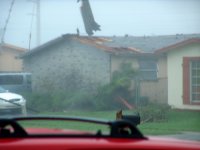 RoofGone_x.jpg798.4 KB · Views: 85
RoofGone_x.jpg798.4 KB · Views: 85 -
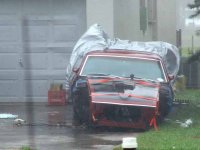 Mach1.jpg66.2 KB · Views: 95
Mach1.jpg66.2 KB · Views: 95 -
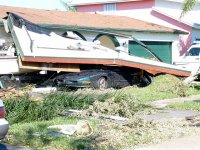 SquashedFirebird.jpg131 KB · Views: 94
SquashedFirebird.jpg131 KB · Views: 94 -
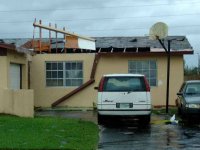 PorchAndRoofGone.jpg76.1 KB · Views: 90
PorchAndRoofGone.jpg76.1 KB · Views: 90 -
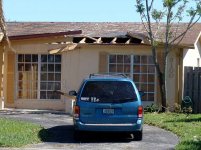 AnotherBrokenRoof.jpg144.6 KB · Views: 94
AnotherBrokenRoof.jpg144.6 KB · Views: 94 -
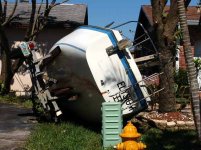 Boat.jpg155.7 KB · Views: 38
Boat.jpg155.7 KB · Views: 38 -
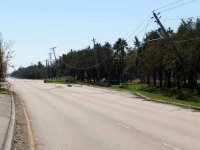 FlamingoRoad.jpg98.8 KB · Views: 37
FlamingoRoad.jpg98.8 KB · Views: 37 -
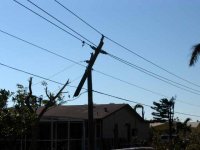 BrokenPole.jpg79.1 KB · Views: 37
BrokenPole.jpg79.1 KB · Views: 37 -
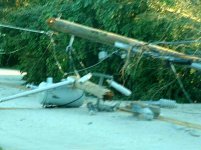 Transformer2.jpg103.5 KB · Views: 40
Transformer2.jpg103.5 KB · Views: 40 -
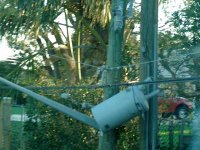 transformer1.jpg121.4 KB · Views: 42
transformer1.jpg121.4 KB · Views: 42
- Status
- This old topic is closed. If you want to reopen this topic, contact a moderator using the "Report Post" button.